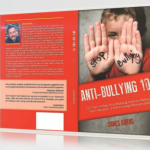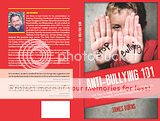Activity – Wrinkled Wanda – On chart paper, have the participants trace an outline of a full body person. (See below for an example) Once the outline has been traced, the participants will write unkind, rude, and disrespectful statements all over the outline. These are statements that could be made to another person like, “You’re a loser, Nobody likes you, You are dumb.” Identify the drawing as a girl named Wanda. After Wanda is completely filled with a variety of negative comments, have the participants crumple the drawing, and then un-crumple it. Post the wrinkled drawings around the room. Explain to the class that these drawings are examples of what negative comments can do to a person who is bullied. Bullying comments can destroy a person’s self image and often leads to a defeated body language in the victim.
Next have the participants do the drawing again. This time write as many positive comments on the drawing as possible. Statements like, “You did such a nice job, or I enjoy your friendship. Fill it with really nice statements. Cut this drawing out, but don’t wrinkle it. Post these drawings around the room. This person is now just called Wanda. What is the difference between the two? Have the participants get into base groups and discuss how they would introduce this lesson to their students and invent any variations on the activity that would be helpful to their students.
Activity – The toothpaste activity – Ask for a volunteer to come to the front of the room. Place a strip of masking tape on the length of the table. With a tube of toothpaste, have the volunteer run a bead of toothpaste on the length of the masking tape. Now ask the participant to put the toothpaste back in the tube. Obviously, it can’t be done. This is an example of how hurtful words once spoken cannot be taken back. Bullies say hurtful words frequently and need to know the impact that their words have on their victims.
Activity – Who am I? This activity requires an illustration about something that happened to me from the time I was in the 6th grade until I graduated from high school. My name is Jim and it became rather endearing to some to call me Jimbo. I really didn’t mind it but someone decided to drop the Jim at some point and call me Bo. I accepted the handle but way down deep I wish that folks would just call me by my real name, Jim. Oh, everyone meant no harm, but my parent’s, teachers, friends, coaches, all called me Bo. I didn’t have the heart to tell them that I didn’t like it. I lived with it. Once I got to college, I made everyone aware that my name was Jim. Often we as teachers can call students by names that we hear other students call them, and may not even be aware that they may not like being called certain names. Address your students by their actual name to avoid leveling the ground and jeopardizing your authority. If you have any question about this ask yourself what Beaver Cleaver’s teacher called him. “Theodore.”
Have the participants write down on a sheet of paper names that they were called when they were younger or that they may even be called now. After they have done this have them crumble up the paper and throw it in the garbage can as indicator that they will never be called this name again. Next have the participants write down on another sheet of paper what they want to be called as an indicator that this is what my name actually is.





